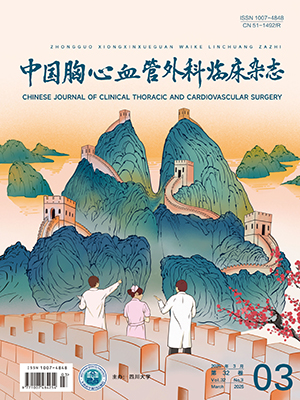| 1. |
Lacour-Gayet F, Piot D, Zoghbi J, et al. Surgical management and indication of left ventricular retraining in arterial switch for transposition of the great arteries with intact ventricular septum. Eur J Cardiothorac Surg, 2001, 20(4):824-829.
|
| 2. |
Planche C, Lacour-Gayet F, Serraf A. Arteral switch. Pediatr Cardiol, 1998, 19(4):297-307.
|
| 3. |
Hisatome K, Sato T, Isomura T, et al. Rapid twi-stage arterial switch operation. Eur J Cardiothorac Surg, 1995, 9(11):670.
|
| 4. |
Colan SD, Boutin C, Castañeda AR, et al. Status of the left ventricle after arterial Switch operation for transposition of the great arteries. Hemodynamic and echocardiographic evaluation. J Thorac Cardiovasc Surg, 1995, 109(2):311-321.
|
| 5. |
Boutin C, Jonas RA, Sanders SP, et al. Rapid two-stage arterial Switch operation. Acquisition of left ventricular mass after pulmonary artery banding in infants with transposition of the great arteries. Circulation, 1994, 90(3):1304-1309.
|
| 6. |
何德沛.动脉转位术治疗65例新生儿完全性大动脉错位.中国胸心血管外科临床杂志, 1997, 4(3):11-13.
|
| 7. |
徐志伟, 苏肇伉, 丁文祥, 等.快速二期动脉转位术纠治新生儿完全型大动脉转位.中国胸心血管外科临床杂志, 2004, 11(1):12-15.
|
| 8. |
凌庆, 汪涛, 赵萍, 等.新生儿复杂先天性心脏病的外科治疗.中国胸心血管外科临床杂志, 2005, 12(3):155-157.
|
| 9. |
Yacoub MH, Radley-Smith R, Maclaurin R. Two-stage operation for anatomical correction of transposition of the great arteries with intact interventricular septum. Lancet, 1977, 1(18):1275-1278.
|
| 10. |
Jonas RA, Gigilia TM, Sanders SP, et al. Rapid two-stage arterial switch for transposition of the great arteries and intact ventricular septum beyond the neonatal period. Circulation, 1989, 80(3 Pt 1):1203-1208.
|
| 11. |
Sarkar D, Bull C, Yates R, et al. Comparison of long-term outcomes of atrial repair of simple transposition with implications for a late arterial switch strategy. Circulation, 1999, 100(19 Suppl):Ⅱ176-Ⅱ181.
|
| 12. |
Foran JP, Sullivan ID, Elliott MJ, et al. Primary arterial switch operation for transposition of the great arteries with intact ventricular septum in infants older than 21 days. J Am Coll Cardiol, 1998, 31(4):883-889.
|
| 13. |
Devaney EJ, Charpie JR, Ohye RG, et al. Combined arterial Switch and Senning operation for congenitally corrected transposition of the great arteries:patient selection and intermediate results. J Thorac Cardiovasc Surg, 2003, 125(3):500-507.
|
| 14. |
Wong SH, Finucane K, Kerr AR, et al. Cardiac outcome up to 15 years after the arterial Switch operation. Heart Lung Circ, 2008, 17(1):48-53.
|
| 15. |
Kang N, de Leval MR, Elliott M, et al. Extending the boundaries of the primary arterial switch operation in patients with transposition of the great arteries and intact ventricular septum.Circulation, 2004, 110(Suppl Ⅱ):Ⅱ123-Ⅱ127.
|
| 16. |
Yacoub MH, Radley-Smith R, Maclaurin R. Two-stage operation for anatomical correction of transposition of the great arteries with intact interventricular septum. Lancet, 1977, 1(8025):1275-1278.
|
| 17. |
Wemovsky G, Giglia TM, Jonas RA, et al. Course in the intensive care unit after preparatory' pulmonary artery banding and aortopulmonary shunt placement for transposition of the great arteries with low ventricular pressure. Circulation, 1992, 86(5 Suppl):Ⅱ133-Ⅱ139.
|
| 18. |
Giardini A, Khambadkone S, Rizzo N, et al. Determinants of exercise capacity after arterial Switch operation for transposition of the great arteries. Am J Cardiol, 2009, 104(7):1007-1012.
|
| 19. |
Fricke TA, d'udekem Y, Richardson M, et al. Outcomes of the arterial switch operation for transposition of the great arteries:25 years of experience. Ann Thorac Surg, 2012, 94(1):139-145.
|
| 20. |
Chasovskyi K, Fedevych O, Vorobiova G, et al. Arterial Switch operation in the first hours of Life using autologous umbilical cord blood. Ann Thorac Surg, 2012, 93(5):1571-1576.
|
| 21. |
Stoica S, Carpenter E, Campbell D, et al. Morbidity of the arterial Switch operation. Ann Thorac Surg, 2012, 93(6):1977-1983.
|
| 22. |
Ma K, Gao HW, Hua ZD, et al. Palliative pulmonary artery banding versus anatomic correction for congenitally corrected transposition of the great arteries with regressed morphologic left ventricle:Long-term results from a single center. J Thorac Cardiovasc Surg, 2014, doi:10.1016/j.jtcvs.2013.12.044.[Epubaheadofprint].
|
| 23. |
Akhtar MI, Hamid M, Amanullah M, et al. Transatrial access for left atrial pressure(LAP)monitoring line placement in arterial switch operation(ASO)in neonates. J Pak Med Assoc, 2013, 63(11):1430-1432.
|
| 24. |
Di Chiara L, Ricci Z, Brancaccio G, et al. Left ventricular retraining after arterial switch operation facilitated by mechanical circulatory support. J Heart Lung Transplant, 2013, 32(8):842-843.
|
| 25. |
Liu CH, Su JW, Li ZQ, et al. Comparative analysis of early and middle outcomes of the arterial Switch operation in children with complete transposition of the great arteries with ventricular septal defect and severe pulmonary artery hypertension. Chin Med J(Engl), 2013, 126(11):2074-2078.
|
| 26. |
Rios R, Dummer KB, Overman DM. Successful staged surgical repair using rapid pulmonary artery banding in a very-low-birth-weight premature infant who had d-transposition of the great arteries with an intact ventricular septum. Pediatr Cardiol, 2013, 34(8):1935-1937.
|




